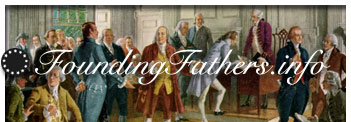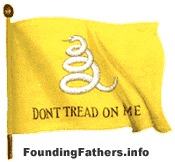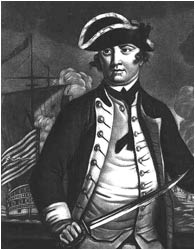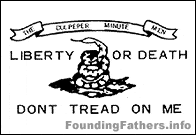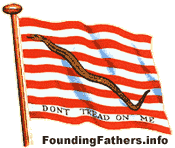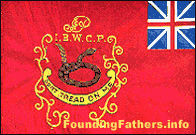| |||
Gadsden Flag HistoryFor the full history of the rattlesnake as a symbol of American independence, click to page one of this story: Dont Tread on Me: The Gadsden Flag.
Colonel Christopher Gadsden and Commodore Esek HopkinsAlthough Benjamin Franklin helped create the American rattlesnake symbol, his name isn't generally attached to the rattlesnake flag. The yellow "don't tread on me" standard is usually called a Gadsden flag, or less commonly, a Hopkins flag. These two individuals were mulling about Philadelphia at the same time, making their own important contributions to American history and the history of the rattlesnake flag. Christopher Gadsden was an American patriot if ever there was one. He led Sons of Liberty in South Carolina starting in 1765, and was later made a colonel in the Continental Army. In 1775 he was in Philadelphia representing his home state in the Continental Congress. He was also one of three members of the Marine Committee who decided to outfit and man the Alfred and its sister ships. Gadsden and Congress chose a Rhode Island man, Esek Hopkins, as the commander-in-chief of the Navy. The flag that Hopkins used as his personal standard on the Alfred is the one we would now recognize. It's likely that John Paul Jones, as the first lieutenant on the Alfred, ran it up the gaff.
It's generally accepted that Hopkins' flag was presented to him by Christopher Gadsden, who felt it was especially important for the commodore to have a distinctive personal standard. Gadsden also presented a copy of this flag to his state legislature in Charleston. This is recorded in the South Carolina congressional journals: "Col. Gadsden presented to the Congress an elegant standard, such as is to be used by the commander in chief of the American navy; being a yellow field, with a lively representation of a rattle-snake in the middle, in the attitude of going to strike, and these words underneath, "Don't Tread on Me!"
The Revolutionary standardThe Gadsden flag and other rattlesnake flags were widely used during the American Revolution. There was no standard American flag at the time. People were free to choose their own banners.
The Minutemen of Culpeper County, Virginia, chose a flag that looks generally like the Gadsden flag, but also includes the famous words of the man who organized the Virginia militia, Patrick Henry, i.e. "Liberty or Death."
The First Navy Jack features an uncoiled rattlesnake winding its way across a field of thirteen red and white stripes. One of the most interesting variations is the flag of Colonel John Proctor's Independent Battalion from Westmoreland County, Pennsylvania.
Tradition holds that in May 1775, when the citizens of Westmoreland gathered at the Hannastown Tavern and issued their own Declaration of Independence, they tore down the British flag that was flying there and made some modifications. The original flag had an open red field with the British ensign in the upper corner. They painted a coiled rattlesnake and its "Don't Tread on Me" warning onto the center, as if ready to strike at the Union Jack. This flag still survives. It's at the Fort Pitt Museum in Pittsburgh. According to the director of the museum, Alan Gutchess, it is "the only surviving rattlesnake flag from the Revolutionary era. ... The flag is in excellent condition and is far more detailed than reproductions of it." After the Revolution, rattlesnake flags became less common. General Washington and many members of Congress preferred stars, stripes, and more conventional symbols, such as the eagle. Over the years the Gadsden flag has become more and more associated with rebellion and totally disassociated with pride in one's government. Some say that this makes it a lousy symbol for the Fourth of July. But I say that makes it a great symbol for celebrating the spirit of July 4, 1776.
|
More Resources
This is my Web site devoted to the Gadsden flag. It includes free Gadsden flag clip art, recommendations on where to buy flags, t-shirts & sweatshirts, stickers & mugs, plus free Gadsden flag Windows desktop wallpaper.
The sister site to Gadsden.info. The First Navy Jack is enjoying renewed popularity these days thanks to an order from the Secretary of the Navy that directs all U.S. Navy ships to fly the First Navy Jack for the duration of the War on Terrorism.
| ||||
|
|
